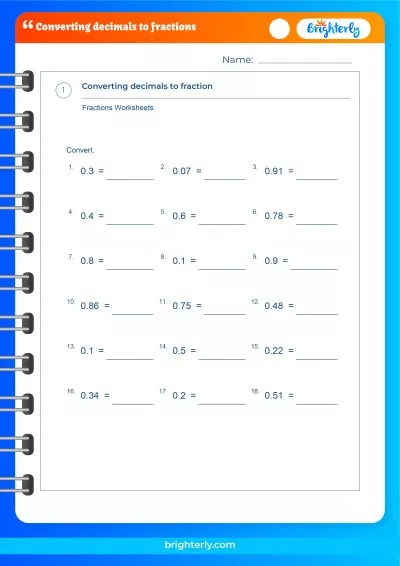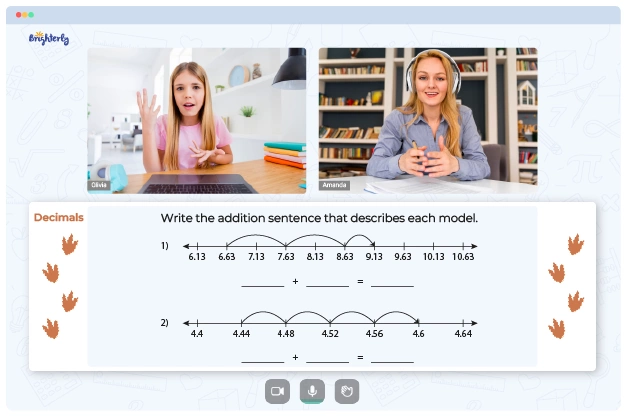Decimals – Definition, Types, FAQs, Examples
Updated on January 4, 2024
Decimals are not only crucial for understanding mathematical concepts but also for navigating real-world scenarios. From managing finances to measuring ingredients in cooking, decimals are woven into the fabric of our everyday experiences. As we unravel the intricacies of decimals, we’ll uncover how they empower us to tackle mathematical challenges with greater ease and confidence. Join us at Brighterly as we illuminate the path to mathematical mastery, one decimal at a time.
At Brighterly, we believe that the foundation of mathematical proficiency lies in grasping the fundamentals. That’s why we’re committed to providing engaging and comprehensive resources to help children unlock the full potential of decimals. Through our expertly crafted lessons and interactive activities, children will embark on a journey of discovery, fostering a deep understanding of decimals and their real-world applications. With Brighterly, the power of decimals is just a click away. So let’s get started on this exciting journey to decimal enlightenment!
What are Decimals?
Decimals are numbers that include a decimal point (.) to indicate a fractional part. The decimal system, also known as the base-10 system, uses ten different digits: 0, 1, 2, 3, 4, 5, 6, 7, 8, and 9. Each position to the right of the decimal point represents a power of 10 with a negative exponent. For example, the first position to the right of the decimal point represents tenths (10^(-1)), the second position represents hundredths (10^(-2)), and so on.
Decimals are useful for expressing numbers with fractions or for representing numbers that cannot be written as whole numbers. They are widely used in mathematics, science, engineering, and daily life, as they allow for more precise calculations and measurements.
Types of Decimal Numbers
There are three main types of decimal numbers:
-
Terminating decimals: These decimals have a finite number of digits after the decimal point. For example, 0.5, 0.75, and 0.125 are all terminating decimals.
-
Repeating decimals: These decimals have a pattern of digits that repeats infinitely after the decimal point. Examples include 0.333… (repeating 3) and 0.142857… (repeating 142857).
-
Non-repeating decimals: These decimals have an infinite number of digits after the decimal point, with no repeating pattern. The most famous example is the irrational number π (pi), which begins as 3.14159… and continues without repeating.
Decimals in Expanded Form
Expanded form is a way of writing decimals that shows the value of each digit in the number. For example, the decimal 0.237 can be written in expanded form as:
This shows that the number is made up of two-tenths (0.2), three-hundredths (0.03), and seven-thousandths (0.007).
Rounding Decimals to the Nearest Tenths
Rounding decimals is a useful skill for estimating and simplifying numbers. To round a decimal to the nearest tenth, follow these steps:
- Locate the digit in the tenths place (the first digit to the right of the decimal point).
- Check the digit in the hundredths place (the second digit to the right of the decimal point).
- If the hundredths digit is 5 or greater, add 1 to the tenths digit. If the hundredths digit is less than 5, leave the tenths digit unchanged.
- Remove all digits to the right of the tenths place.
For example, to round 0.438 to the nearest tenth:
Place Value in Decimals
Place value is the value of each digit in a number, depending on its position. In decimals, each position to the right of the decimal point represents a power of 10 with a negative exponent:
- Tenths place: 10^(-1)
- Hundredths place
- Hundredths place: 10^(-2)
- Thousandths place: 10^(-3)
- Ten-thousandths place: 10^(-4)
Understanding place value in decimals is essential for comparing, adding, subtracting, multiplying, and dividing decimal numbers.
Properties of Decimals
Decimals have several properties that make them useful for mathematical operations:
-
Commutative property: The order of the numbers does not matter when adding or multiplying decimals. For example, 0.3 + 0.5 = 0.5 + 0.3, and 0.2 * 0.4 = 0.4 * 0.2.
-
Associative property: Grouping numbers differently does not change the result when adding or multiplying decimals. For example, (0.2 + 0.3) + 0.5 = 0.2 + (0.3 + 0.5), and (0.2 * 0.3) * 0.4 = 0.2 * (0.3 * 0.4).
-
Distributive property: Multiplying a number by a sum of decimals is the same as multiplying the number by each decimal and then adding the results. For example, 0.2 * (0.3 + 0.5) = 0.2 * 0.3 + 0.2 * 0.5.
-
Identity property: The number 1 is the multiplicative identity for decimals, and the number 0 is the additive identity. For example, 0.3 * 1 = 0.3, and 0.3 + 0 = 0.3.
-
Inverse property: Every decimal has an additive inverse (opposite) and a multiplicative inverse (reciprocal). For example, the additive inverse of 0.3 is -0.3, and the multiplicative inverse of 0.3 is 1/0.3 (or 10/3).
Solved Examples On Decimal
Example 1: Add 0.3 and 0.5.
Solution: 0.3 + 0.5 = 0.8
Example 2: Subtract 0.75 from 0.9.
Solution: 0.9 – 0.75 = 0.15
Example 3: Multiply 0.2 by 0.4.
Solution: 0.2 * 0.4 = 0.08
Example 4: Divide 0.6 by 0.2.
Solution: 0.6 / 0.2 = 3
Practice Problems On Decimal
- Add 0.14 and 0.26.
- Subtract 0.5 from 0.7.
- Multiply 0.3 by 0.6.
- Divide 0.9 by 0.3.
Decimal – Definition with Examples
In summary, a decimal is a number that includes a decimal point to indicate a fractional part. Decimals are essential in mathematics and daily life, as they allow us to express numbers with greater accuracy and ease. There are three main types of decimals: terminating, repeating, and non-repeating. Understanding the properties and place value of decimals is crucial for performing mathematical operations with them.
Brighterly offers a wide variety of math worksheets to help children practice working with decimal.
Conclusion
Decimals are an essential part of mathematics, allowing for more precise calculations and measurements. By understanding the different types of decimals, their properties, and how to use them in mathematical operations, children can gain a solid foundation in mathematics and apply their knowledge in various real-world situations.
From comparing prices at the grocery store to calculating distances, decimals play a vital role in our everyday lives. By mastering decimals, children can improve their problem-solving skills, critical thinking abilities, and overall mathematical competence. As a result, they will be better equipped to tackle increasingly complex mathematical concepts as they progress in their education.
At Brighterly, we are dedicated to making learning mathematics enjoyable and accessible for children. Our comprehensive resources, engaging activities, and supportive community help children develop their skills and confidence in mathematics, setting them up for success in the classroom and beyond.
Frequently Asked Questions On Decimal
What is the decimal point?
The decimal point is a dot (.) used to separate the whole number part from the fractional part in a decimal number.
How do you compare decimals?
To compare decimals, start by comparing the whole number part. If the whole number parts are equal, compare the decimal parts from left to right, digit by digit, until you find a difference.
How do you add and subtract decimals?
To add or subtract decimals, line up the decimal points, and perform the operation as you would with whole numbers. Fill in any missing digits with zeros, if necessary.
How do you multiply decimals?
To multiply decimals, multiply the numbers as if they were whole numbers. Then, count the total number of decimal places in both factors, and place the decimal point in the product so that it has the same number of decimal places as the sum of the decimal places in the factors.
How do you divide decimals?
To divide decimals, move the decimal point in the divisor (the number you are dividing by) to the right until it becomes a whole number. Then, move the decimal point in the dividend (the number being divided) the same number of places to the right. Finally, perform the division as you would with whole numbers.
Information Sources
For further reading on decimals, you may refer to the following sources:






